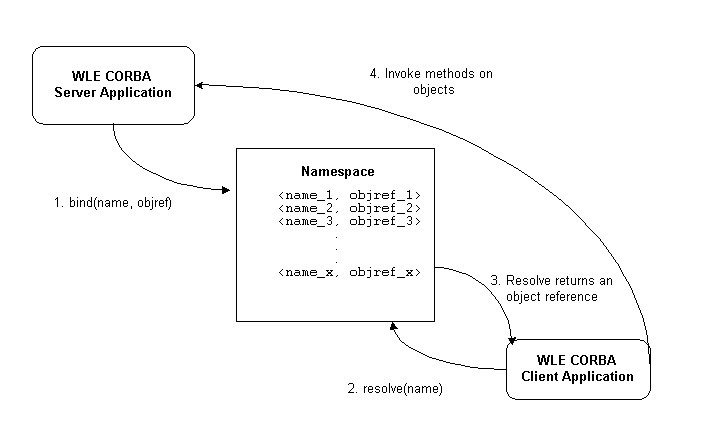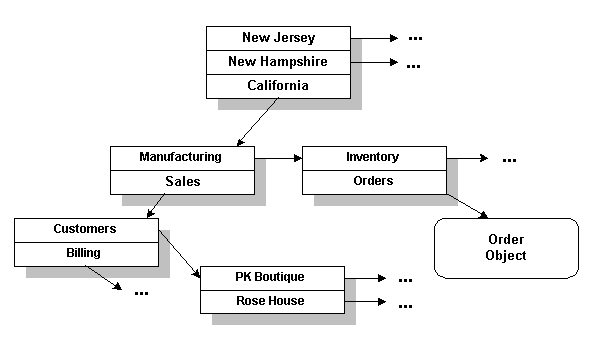


|

|
|
|
|
Overview of the CORBA Name Service
This topic includes the following sections:
The CORBA Name Service
The WebLogic Enterprise Name Service (referred to throughout this document as the CORBA Name Service) allows WebLogic Enterprise CORBA server applications to advertise object references using logical names. WebLogic Enterprise CORBA client applications can then locate an object by asking the CORBA Name Service to look up the name.
The CORBA Name Service provides:
The CORBA Name Service is a layered product. The CORBA Name Service is installed as part of the WebLogic Enterprise product. For a complete description of the supported platforms and the installation procedure, see the BEA WebLogic Enterprise Installation Guide.
When using the CORBA Name Service:
Figure 1-1 presents an overview of the CORBA Name Service.
Figure 1-1 CORBA Name Service

Understanding the CORBA Name Service
Figure 1-2 shows how a namespace might be used to store objects that make up an order entry application.
Figure 1-2 A WebLogic Namespace

The illustrated application organizes its namespace by geographic region, then by department. To implement the namespace using the objects in the CORBA Name Service, each shadowed box would be implemented by a NamingContext object. A NamingContext object contains a list of CosNaming::Name data structures that have been bound to application objects or to other NamingContext objects. NamingContext objects are traversed to locate a particular name. For example, the logical name California.Manufacturing.Order can be used to locate the Order object.
A CosNaming::Name data structure is not simply a string of alphanumeric characters; it is a sequence of one or more CosNaming::NameComponent data structures. Each CosNaming::NameComponent data structure contains two strings, id and kind. The CORBA Name Service does not interpret or manage these strings, except to ensure that each ID is unique within a given NamingContext object.
WebLogic Enterprise CORBA server applications use the bind() method of the NamingContext object to bind a name to an application object contained in the server application. WebLogic Enterprise CORBA client applications use the resolve() method of a NamingContext object to locate an object using a binding.
The CORBA Name Service also provides a BindingIterator object and a NamingContextExt object. The BindingIterator object allows a client application to obtain a specified number of bindings in each call. The NamingContextExt object provides methods to use Uniform Resource Locators (URL) and stringified names.
For a complete description of the objects in the CORBA Name Service and their interfaces, see CORBA Name Service Reference.

|

|
|
|
|
Copyright © 2000 BEA Systems, Inc. All rights reserved.
|